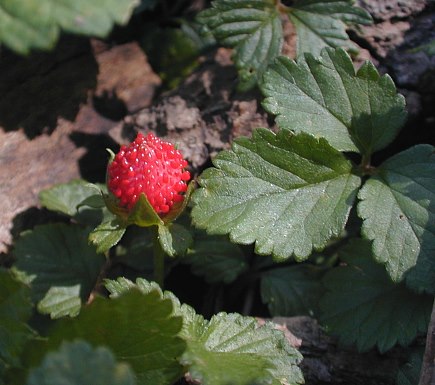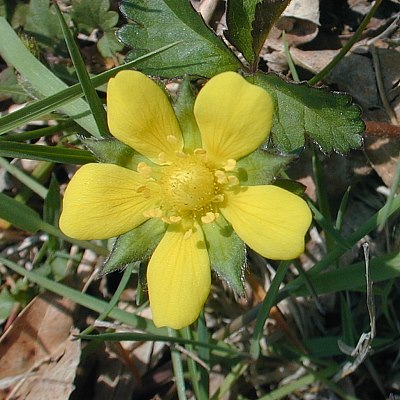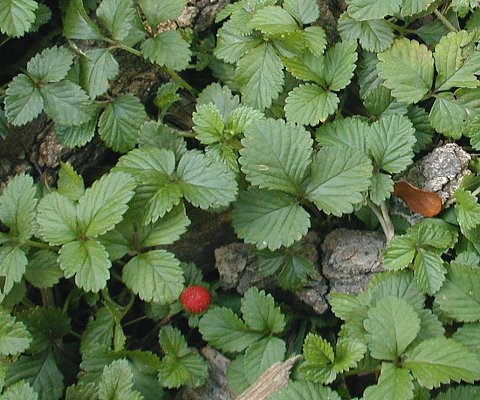Description: This herbaceous perennial plant consists of trifoliate basal leaves with long petioles that develop from a crown of roots. The petioles have appressed white hairs. Each blunt-tipped leaflet is broadly ovate or obovate, spanning about ¾–1¾" in length and ½–1¼" across. The middle leaflet is wedge-shaped at the base. The margins of these leaflets are coarsely crenate-serrate, and they have conspicuous pinnate venation. The upper leaflet surfaces are medium to dark green and hairless. Occasionally, light green to reddish purple stolons develop from the crown that are long and slender. They have appressed hairs and form new plantlets at their tips.

The crown also produces one or more flowering stalks, each with a single flower. Each flower is about ¾" across, consisting of 5 yellow petals, 5 green sepals, numerous stamens with yellow anthers, and a central yellow receptacle with numerous pistils. The triangular sepals are about as long as the petals. Immediately underneath each flower, there are spreading bracts that are green and rectangular-shaped. Each bract has 3 teeth along its outer edge. The blooming period occurs from late spring to mid-summer and lasts about a month. Each flower is replaced by a bright red drupe about ½" across that is spheroid or ovoid in shape. There are small red seeds scattered across its rather bumpy surface. The sepals turn upward around the drupe. The drupes of this species have a bland flavor and slightly dry texture. A colony of plants produces flowers and drupes sparingly, as most of the available energy is devoted to vegetative reproduction. The root system consists of crown with coarse secondary roots, which also produces stolons and possibly rhizomes. This species forms clonal colonies readily.

Cultivation:
The
preference is partial sunlight, fertile soil, and moist to mesic
conditions. In open semi-shaded situations, it can spread aggressively
to form a ground cover. The drupes are edible, but tasteless.
Range & Habitat: Mock
Strawberry occurs sporadically in only a few counties in Illinois (see Distribution
Map). It is probably more common that official records
indicate, and likely spreading to other areas of the state. It occurs
in semi-shaded areas of lawns primarily, where it can adapt to a
regimen of regular mowing because of its low-growing habit. This
species was introduced from southern Asia as an ornamental plant.
Faunal Associations:
The flowers attract small bees and flower flies. Birds probably eat the
drupes and spread them around, although the drupes of Mock Strawberry
appear to be less attractive to native birds than those of Fragaria
virginica (Wild Strawberry). Rabbits probably eat the foliage
of this species.

Photographic
Location:
Several colonies of Mock Strawberry were growing around a small tree at
the edge of a lawn in a semi-shaded area. This was located on the
campus of the University of Illinois in Urbana, Illinois.
Comments:
This dainty species has attractive foliage, flowers, and drupes. It
resembles Wild Strawberry, except that its flowers are yellow, rather
than white, and the trifoliate leaves are lower-growing and smaller in
size. While the drupes of Wild Strawberry tend to hang downward (with
the reddish green sepals above), the drupes of Mock Strawberry are held
erect with the green sepals originating beneath each drupe. The ripened
drupes of Wild Strawberry are juicy with a pleasant sweet-tart flavor,
while the ripened drupes of Mock Strawberry are dry and bland. Some
yellow-flowered Potentilla spp. (Cinquefoils) have
compound leaves that resemble the foliage of Mock Strawberry, however
they don't produce any drupes and their compound leaves often have 5 or
more leaflets. Another common name for Duchesnea indica
is Indian Strawberry, which refers to the nation of India.